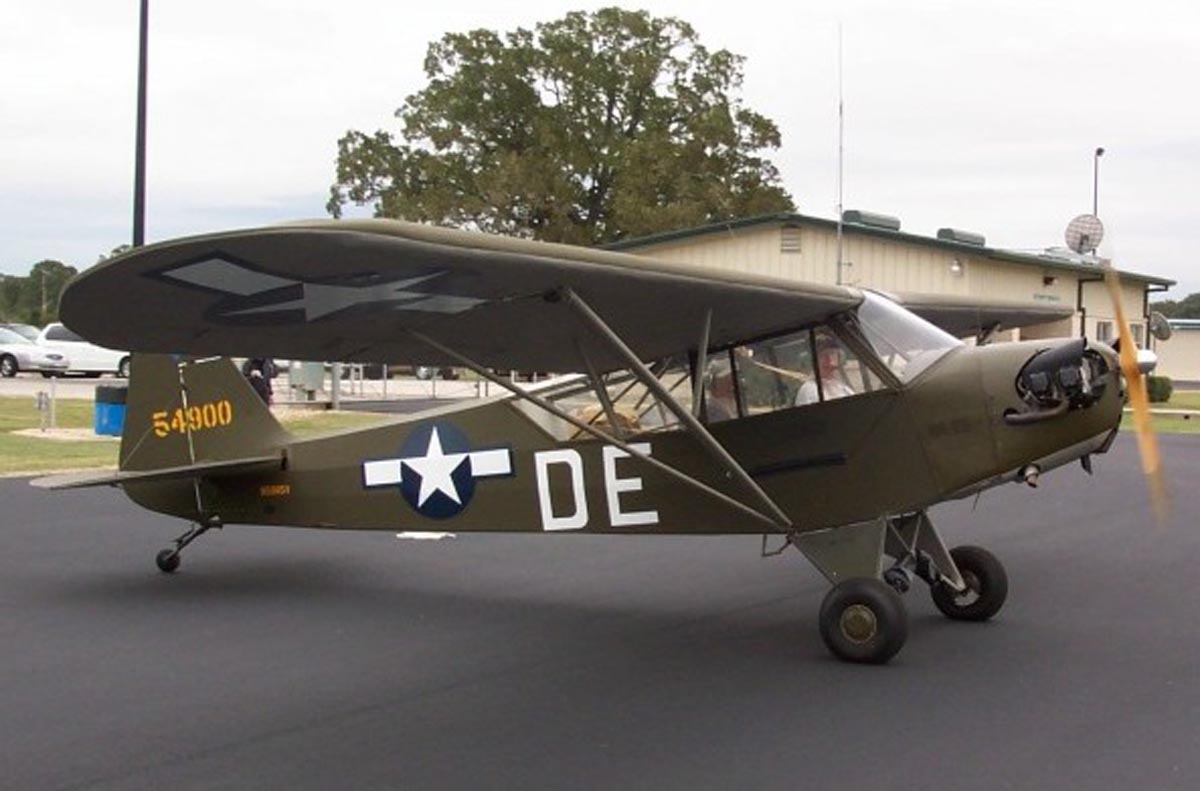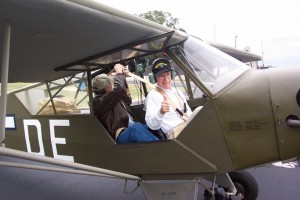
Hugh O’Donnell was in the process of restoring an L-4 he found in Colorado when he read Jim Stegall’s book and decided to designate it as a Texas division of the 155 Infantry. Restoration began in February 2004 and concluded in August 2005.
By Jay Carpenter, reprinted with permission of the Texas Aviation Association
This wasn’t your typical $100 hamburger or pancake breakfast. Rather, this was a gathering of family and friends of James R. Stegall, from Austin, Texas. Stegall had agreed to meet aircraft restorer Hugh O’Donnell, along with his partners Chris Hartman and Don Johnson, at a “reunion” at Fayette Regional Air Center Airport in La Grange, Texas. The owners of El Hopper Aero Club had flown a fully restored Piper L-4 Cub from their operations located at Houston Southwest Airport (AXH) to the La Grange airport.
The aircraft was used extensively in World War II, the Korean Conflict and the Vietnam War as a spotter plane. The L-4 was known as the slowest flying aircraft in combat. It was designed that way to facilitate observations of combat theaters all around the world. Typically, the pilot sat in front and an observer sat facing backward behind the pilot. The pilot would fly assigned headings low and slow. The observer would have a map table in front of him and would radio in information about enemy positions or give feedback to artillery troops on the ground.
When I caught up to Stegall and his family, it was cool and cloudy. After short introductions, someone said, “I hear it! Here it comes!” Out of the southwestern sky was a small dot of an airplane flying just below the stratus clouds. It seemed to take forever for the taildragger Cub to make the pattern to land. The plane flew so slow that for a moment I thought it would stall and fall from the sky.
“No,” replied Stegall. “That’s the typical cruise speed for the Grasshopper.”

Jim Stegall pauses for a photograph before hopping into the front cockpit of the L-4 Cub. Hugh O’Donnell is in the back.
As the plane taxied up to the FBO, we could see the markings on the dark green fabric fuselage. It looked authentic in every detail. Jim Stegall walked up to the plane after the prop stopped. One could tell that he was admiring an old friend. Although he had never seen this particular L-4, it was identical in every detail to the one he learned to fly in the Army. He had less than 100 hours flying experience when his division landed in Salerno, Italy, in the fall of 1943.
“That was the way it was back then,” Stegall explained. “You trained quickly and went into combat. That’s what I wanted to do. Without us (spotters), the war would’ve lasted a lot longer. We were able to kill with accuracy. We’d tell the artillery where to aim and then report on the effect of our actions.”
The enemy knew the importance of the spotters. German fighter aircraft were there to search and destroy Allied fighters and bombers. However, it was told that if a German air force pilot shot down one of these L-4s, they’d get 14 days vacation in Berlin.
“That’s how important we were,” Stegall said.
Tales of a Grasshopper pilot
Stegall wrote of his adventures in WWII and the Korean War in a book entitled “Grasshopper Pilot – Salerno To The Yalu,” available from Ravnhaus Press.
One of the most impressive tales in the book is when Stegall encountered a German ME-109 fighter. The pilot came up on his six o’clock and fired the aircraft’s 20mm cannon. One of the shells hit the left wing strut and exploded. The strut held together and Stegall was able to dive to a lower altitude.
“We never saw him until the tracer bullets came by,” he said. “He had a clear shot at me. We would deliberately fly at around 55 mph so we could observe the details on the ground. The 109 was probably traveling at around 250 knots when he gave his burst. He had me in his crosshairs but my guardian angel said to the German, ‘Move over just a little bit; you’re going to miss this guy.'”
The fighter pilot, out of ammunition, flew alongside Stegall’s L-4. They looked at each other and then the fighter sped off over the horizon.
“He (my guardian angel) has helped me so many times that my wife says I’ve worn out many guardian angels,” a grinning Stegall said. “I was able to land safely.” Later that same day, he was back in the air on another spotter mission.

Don Johnson hand props the engine before Jim Stegall’s ride in the L-4 Cub. Jay Carpenter’s Tiger is in the background.
Stegall was in the Army for 18 years. In the Korean War, he continued to serve as a spotter pilot, hopping from shore to shore as the frontlines shifted between the North and South Koreans, and later when the Chinese invaded.
“In December of ’50, the Chinese had overrun North Korea and we were ordered to evacuate south,” he recalled. “However, when we received our orders, it was already dark, and we couldn’t fly at night.”
Stegall and his partner were stranded at an elevated airfield. The temperature was around 20 below zero. All through the night, they alternated between huddling in a small shack to stay warm and going out to hand prop the engine of the spotter plane.
“We had to keep doing that all night so the engine oil would stay warm, otherwise it would never start in those temperatures,” he said. “All the while, the enemy was close by.”
Stegall and his associate would place their hands on the rocker boxes of the engine to keep warm. When the cylinders became cold again, they would restart the engine. They did that all night. At the break of dawn, they filled the plane with the gas they had left and took off, leaving the gas cans behind.

Don Johnson hand props the engine before Jim Stegall’s ride in the L-4 Cub. Jay Carpenter’s Tiger is in the background.
Later, in Ham Hung, the U.S. Army was evacuating onto ships. Stegall landed just about dark and could see the Chinese army in the valley below. He could see each camp lit up by small fires they used for cooking.
“They had us encircled and you could see exactly where they were,” he said. “It was kind of eerie.”
The L-4
Hugh O’Donnell, who lives in Fresno near Houston Southwest Airport, was in the process of restoring an L-4 he had found in Colorado when he read Stegall’s book. He decided to designate it as a Texas division of the 155 Infantry.
“We had all the drawings from Piper and we tried to make it as authentic as we could,” O’Donnell said. “I asked if we could put Jim’s name on it and Jim agreed.”
O’Donnell and associates started full restoration of the L-4 in February 2004 and finished in August 2005. The plane has flown about 35 hours since the complete restoration.

It was love at first sight when Jim Stegall met his future wife, Doris. A friend set them up on a blind date and they were married just before he was shipped overseas in 1943.
The fabric has seven to eight coats of paint. The aircraft weighs 750 pounds when empty and 1,220 pounds gross weight with fuel and people. It has a 12-gallon main tank in front of the cockpit. O’Donnell put in another 8-gallon tank in the left wing, which adds up to 120 pounds of fuel. The engine burns 4.4 gallons per hour.
After posing for dozens of pictures at the reunion, Stegall was offered a ride in the beautiful L-4 Cub. Even though he’s in his eighties, he had no trouble slipping into the front seat. With O’Donnell in the back, the engine was hand propped by Don Johnson.
After pulling the prop through a couple of turns with the magnetos turned off, Johnson gave the command, “Switch on,” and then repeated it. Another pull on the prop and the engine fired right up.
The smile on Stegall’s face was infectious as the crowd of onlookers cheered. The plane slowly taxied to the end of Runway 16. After a short run-up, the little plane lined up with the centerline and took off, using only about 100 feet of runway. The smooth purr of the engine pulled the aircraft slowly out to the West. The crowd waved and cheered as Stegall and O’Donnell flew off into the gray sky.
The little Cub returned in about half an hour, making a smooth landing. As Stegall and O’Donnell taxied back to the FBO, they were met with more cheers. After additional photographs and interviews, the crowd caravanned to a local BBQ shed for lunch. A splendid time was had by all!












